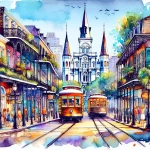Situated on the West Bank of New Orleans stands the historic neighborhood of McDonoghville, a testament to the city’s profound heritage and the lasting impact of one of its most influential figures, John McDonogh. This frequently overlooked area has played a crucial role in shaping the development of the West Bank and continues to captivate visitors with its distinct architectural legacy.
In This Article
TL;DR
- McDonoghville was established on land owned by philanthropist John McDonogh in the early 19th century.
- The neighborhood significantly contributed to the growth of the West Bank of New Orleans.
- Today, McDonoghville is a historic district celebrated for its rich architectural heritage.
History of McDonoghville
The narrative of McDonoghville begins in the early 1800s when John McDonogh, a prominent businessman and plantation owner, acquired vast tracts of land on the West Bank of the Mississippi River. McDonogh established several plantations on his property, including the Monplaisir Plantation, which would later become the site of McDonoghville.
As the 19th century progressed, small settlements emerged on McDonogh’s land, laying the foundation for the future neighborhood. In 1913, McDonoghville was officially incorporated into the City of Gretna, marking a significant milestone in its evolution.
John McDonogh’s Legacy
John McDonogh was a complex figure whose influence continues to shape New Orleans to this day. Born in Baltimore in 1779, McDonogh moved to New Orleans as a young man and quickly established himself as a successful businessman and plantation owner.
Like many wealthy individuals of his time, McDonogh relied on enslaved labor to build his fortune. He owned several plantations in Louisiana and Mississippi, where hundreds of enslaved people toiled under harsh conditions. However, McDonogh also developed an emancipation program for some of his enslaved individuals and supported the American Colonization Society, which sought to establish colonies for freed enslaved people in Africa.
Upon his death in 1850, McDonogh bequeathed a significant portion of his wealth to establish schools in New Orleans and Baltimore. These schools, known as McDonogh Schools, provided education for children from all backgrounds and played a crucial role in the development of public education in both cities.
Architectural Heritage
As McDonoghville grew in the early 20th century, it experienced a period of rapid residential development, particularly after the installation of a modern waterworks system. The neighborhood became known for its distinctive architectural styles, with Neoclassical Revival and Craftsman homes dominating the streetscape.
In 2005, the City of Gretna recognized the significance of McDonoghville’s architectural heritage by designating it as a local historic district. The Historic District Commission was established to oversee exterior changes to historic buildings and ensure that the neighborhood’s character is preserved for future generations.
Preservation Efforts
The Historic District Commission plays a vital role in maintaining McDonoghville’s unique sense of place. The commission has developed design guidelines to assist residents with renovation projects, ensuring that any changes to historic structures are in keeping with the district’s architectural character.
Financial incentives, such as tax credits and grants, are available for the rehabilitation of historic buildings in McDonoghville. These incentives encourage property owners to invest in the preservation of their homes, helping to maintain the neighborhood’s charm and appeal.
McDonoghville Today
Today, McDonoghville remains a vibrant residential neighborhood within the City of Gretna. Its tree-lined streets and well-preserved historic homes offer a glimpse into the past, while its strong sense of community and pride in its heritage point to a bright future.
Ongoing efforts to preserve and promote McDonoghville’s unique history and architecture have the potential to attract heritage tourism and foster greater community engagement around the district’s cultural resources. As more people experience the hidden gem that is McDonoghville, this historic neighborhood on the West Bank of New Orleans is poised to become a must-see destination for those interested in exploring the city’s rich and diverse past.
Some notable locations to visit in and around McDonoghville include:
1. Gretna Historical Society Museum
Address: 209 Lafayette St, Gretna, LA 70053
Hours: Wednesday-Saturday, 10am-4pm
Admission: Adults $5, Seniors $4, Students $3, Children under 12 free
Contact: (504) 363-1580
2. St. Joseph Church and Gardens
Address: 610 6th St, Gretna, LA 70053
Hours: Church open daily, Gardens open Wednesday-Sunday, 9am-4pm
Admission: Free
Contact: (504) 368-1313
3. Gretna Farmers Market
Address: 300 Huey P. Long Ave, Gretna, LA 70053
Hours: Saturday, 8:30am-12:30pm
Contact: (504) 362-8661
4. Mel Ott Park
Address: 2301 Belle Chasse Hwy, Gretna, LA 70053
Hours: Daily, 7am-9pm
Admission: Free
Contact: (504) 363-1597
These locations offer visitors a chance to explore the history, culture, and community spirit of McDonoghville and the surrounding areas on the West Bank of New Orleans. From museums and historic churches to farmers markets and public parks, there is something for everyone to enjoy in this charming and often-overlooked part of the city.






